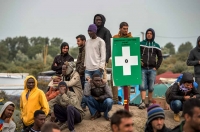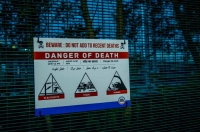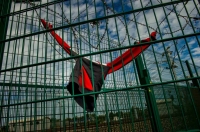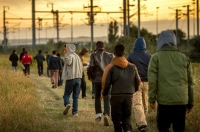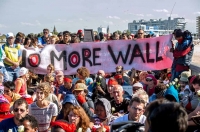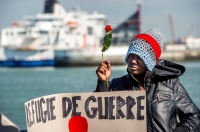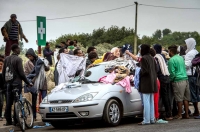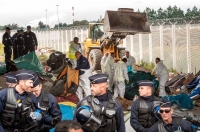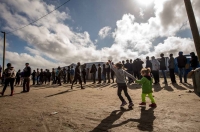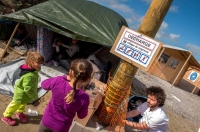Taking pictures in the Calais 'Jungle'
CALAIS, France, October 1, 2015 – “The Jungle” is a conglomeration of tents and shacks near the northern French city of Calais, home to migrants and refugees hoping to reach Great Britain.
Lying a mere 50-some kilometers from Britain, this is the departure point for many ferries and where the trains and trucks enter the Channel Tunnel to speed under the waters of the English Channel.
So the area has become a magnet, with thousands of men, women and children finding themselves here every year, hoping to sneak across the waters into England.
 Migrants hop onto a truck heading for England (AFP / Philippe Huguen)
Migrants hop onto a truck heading for England (AFP / Philippe Huguen)While the French authorities may tolerate this place, and there may be access points for water here and there, it is not adapted to the sea of humanity that has found itself here. Located below sea level, the area becomes a giant swamp every time it rains. Winter is likely to be miserable.
As a photographer in AFP’s Lille bureau, I have covered the phenomenon of the refugees and migrants in Calais for more than 15 years. I was there in 1999 for the opening of the first migrant reception center, dubbed the “Sangatte Center,” an old hangar run by the Red Cross near the Channel Tunnel. I was there when it was closed in December 2002.
The situation back then was very different from what it is now, as the hangar wasn’t accessible to journalists. To know what was going on inside, we had to talk to the people who came out. The “Jungle,” on the other hand, is a small city and I can come and go as I please.
 Migrant from Sudan takes cover from rain inside a makeshift hut (AFP / Philippe Huguen)
Migrant from Sudan takes cover from rain inside a makeshift hut (AFP / Philippe Huguen)Whenever I have time, I drive the hundred or so kilometers from Lille to Calais to take a look around.
According to the latest figures, some 3,000 migrants are living here now, including Eritreans, Pakistanis and Afghans. The tents and makeshift homes are organized around makeshift “streets.” There are makeshift stores – groceries, restaurants, places where one can recharge his mobile phone.
 A makeshift grocery store at the 'Jungle' (AFP / Philippe Huguen)
A makeshift grocery store at the 'Jungle' (AFP / Philippe Huguen)Until last summer, the situation here was more or less simple – the migrants came to Calais, spent some time in the “Jungle” and then managed to cross the Channel one way or another. The flow of humanity kept moving.
But today a dangerous bottleneck has developed, as crossing the Channel has become more and more difficult.
Barbed wire fences up to seven meters high, replete with surveillance cameras, have sprung up around the outskirts of the Calais port. It has become nearly impossible to sneak onto a truck leaving for Great Britain – they now pass through scanners that search for heartbeats and carbon dioxide exhaled by any would be stowaways.
Some migrants try to make it through the tunnel on foot. But it has become extremely dangerous – since the end of June, 11 people have died after being electrocuted or hit by trains, and work is underway to fence off the entrance area completely.
At the same time, the flow of migrants who are ready to try and cross has not ebbed.
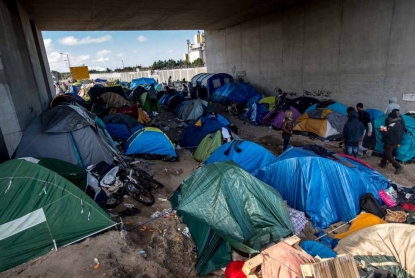 Migrant tents below a bridge (AFP / Philippe Huguen)
Migrant tents below a bridge (AFP / Philippe Huguen)There is no easy solution to the problem. It’s obvious that the people who come here will not turn around and go back to their country. I don’t know how the situation is going to evolve, but it’s not difficult to imagine a day when the border around Calais will become completely impenetrable and the “Jungle” will relocate to other ports along the Channel, or toward Belgium, or the Netherlands.
Every once in a while clashes erupt between the migrants and law enforcement. Police fire tear gas to disperse the crowd that gathers around the Channel Tunnel terminal, trying to get through the closures. The show of force doesn’t seem to make too big of an impression on the migrants, many of whom come from countries where law enforcement usually fires live rounds with Kalashnikovs.
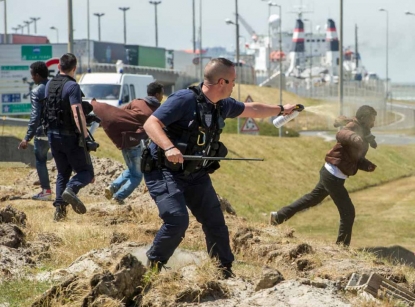 French riot police prevent migrants from sneaking onto trucks heading to England (AFP / Philippe Huguen)
French riot police prevent migrants from sneaking onto trucks heading to England (AFP / Philippe Huguen)In the decade and a half that I have covered this place, I have never witnessed extreme police violence here in Calais. The migrants who are caught near the port or the Eurotunnel terminal are usually released a bit further away. Police can’t put everyone in the detention center and many of the refugees have filed applications for political asylum, which prevents them from being deported while their cases are reviewed.
Coming to the “Jungle” is easy. What’s harder is taking pictures. It is out of the question to arrive and just start snapping away. The work takes time. I start by talking to people and I don’t take out my camera until I sense that the moment has come to ask for permission to photograph. Sometimes, the feeling never comes and I don’t take out my camera at all. I can’t tell you how many times I had left Calais without having taken a single image.
The migrants’ attitude toward having their picture taken depends on their nationality. Eritreans and Sudanese don’t have any problem with it. With Syrians, it depends. With Afghans and Pakistanis, it’s a lot more complicated. I’ve had it happen that after amicably talking with Afghans for a good half hour or more, I’ve then been thrown out as soon as I make a move to take out my camera.
 A migrant cuts a fellow refugee's hair (AFP / Philippe Huguen)
A migrant cuts a fellow refugee's hair (AFP / Philippe Huguen)Overall though, the migrants are rarely aggressive with photographers. But on occasion I have had difficulties with certain activists from groups like “No Borders,” an organization that advocates abolishing borders and whose activists live in the “Jungle” with the refugees. They don’t like us. They have at times called us the “government press,” useless “predators” who “make money off others’ misery.”
To be fair, I have witnessed unethical behavior by journalists. Now that the main migrant story is in central Europe, Calais is no longer in the media spotlight and not many of us remain to keep tabs on the situation, so the work flows with no problems. But in August, when hundreds of television cameras were here, the migrants at times had the impression of being treated like animals in a zoo…
Philippe is an AFP photographer based in the northern French town of Lille. This blog was written with Roland de Courson in Paris and translated by Yana Dlugy. The original French blog can be found here.
Click on an image to view the slideshow:


